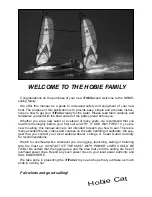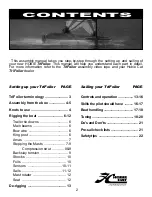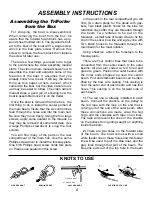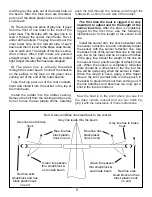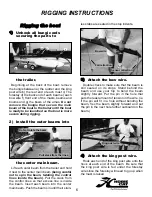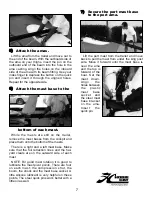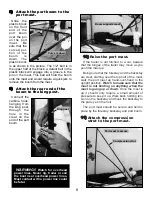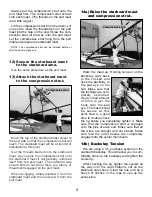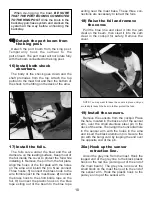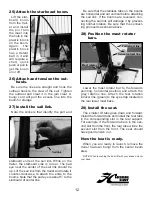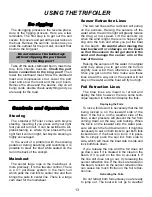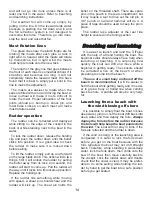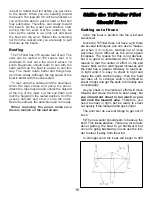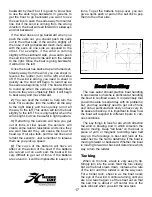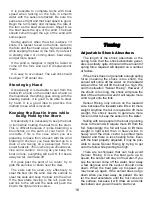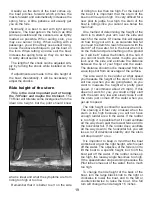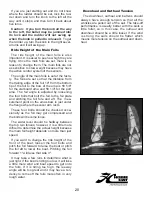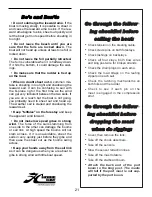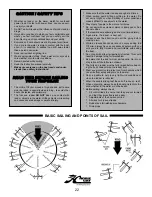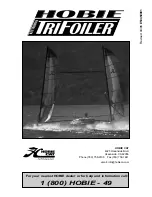
and will not go into irons unless there is at
least one foil in the water. Refer to beaching
and launching instructions.
The weather foil will come up simply by
pulling on the line. On the leeward side water
pressure is pushing the foil down and in and
the foil retraction system is not designed to
overcome this force. Therefore, go into irons,
stop the boat, and raise that foil.
Mast Rotation lines
The green lines near the pilot's thighs are for
rotating the masts after each gibe or tack in
light wind. In heavier wind the masts will rotate
by themselves, but in light wind the masts
need help to rotate onto the new tack.
The length of the grey line that goes between
the front of each mast is somewhat critical. If it
stretches and becomes too long, it will not
completely rotate the leeward mast. We have
found that it is best to simply put a knot in the
line to make the adjustment.
The masts are easiest to rotate when the
sails are filled with wind and driving the boat. A
loose outhaul will make it more difficult to
rotate the mast. Proper lubrication of the four
joints (shroud pin, boom pin, shock pin, and
mast base socket) on each mast will make
mast rotation easier.
Rudder operation
The rudder can be retracted and deployed
while sitting on the edge of the cockpit in the
back or while standing next to the boat in the
water.
To lock the rudder down, release the holding
clip and push the rudder down until the bullet
clicks into position. It is a good idea to check
the rudder to make sure it is locked down
before sailing.
To lift the rudder, simply pull up and forward
on the large black knob. This action will do two
things, first it will unlock the rudder by pulling
the bullet away from its lock, and second, the
rudder will start to come up. Pull the rudder all
the way until it locks into its locked-up position.
Replace the holding clip.
If the rudder hits something while moving
with speed, a shear pin should shear and the
rudder will kick up. The shear pin holds the
bullet on the threaded shaft. There are spare
pins in the pouch in the rear compartment, but
it may require a tool to drive out the old pin. A
1/8" punch or nail and hammer will do it. A
piece of tape should be used to keep the pin in
place.
The rudder rake adjuster or the rear ride
height is covered in the tuning section.
Beaching and launching
It is easier to launch and land the TriFoiler
with the help of a friend holding the boat. The
beginner sailor should always have help when
launching or beaching. It is surprising how
quickly the boat can drift and move while a
beginner is getting ready. The sensors should
be retracted when on the beach or when
preparing to come into the beach.
The use of a small buoy anchored off the
beach is recommended.
It will be easier to
hold the boat while getting ready and it is easi-
er to grab a buoy or trailed line when coming
back to shore. A paddle will also be very help-
ful.
Launching from a beach with
the wind blowing off shore
It is possible to simply float the boat in knee
deep water, jump on, let the boat drift back into
deep water and then deploy the foils.
Always
deploy the foils before the rudder because
the foils will help keep the boat pointed into
the wind.
The boat will not stay in irons if the
foils are retracted and the rudder is down.
If the wind is strong or the launching area is
congested, it is safer to lock the foils down
before you get on the boat because with the
foils retracted the boat may not drift straight
back. Therefore, while standing in waist-deep
water, lock the foils down, then climb onto the
bow of the boat, then move carefully back to
the cockpit. Lock the rudder down and double
check that the coast is clear. It may be prefer-
able to do some sailing while holding the rud-
der by hand to get the boat into a safe position
before you get seated.
14
Summary of Contents for TriFoiler
Page 1: ...ASSEMBLY MANUAL...


